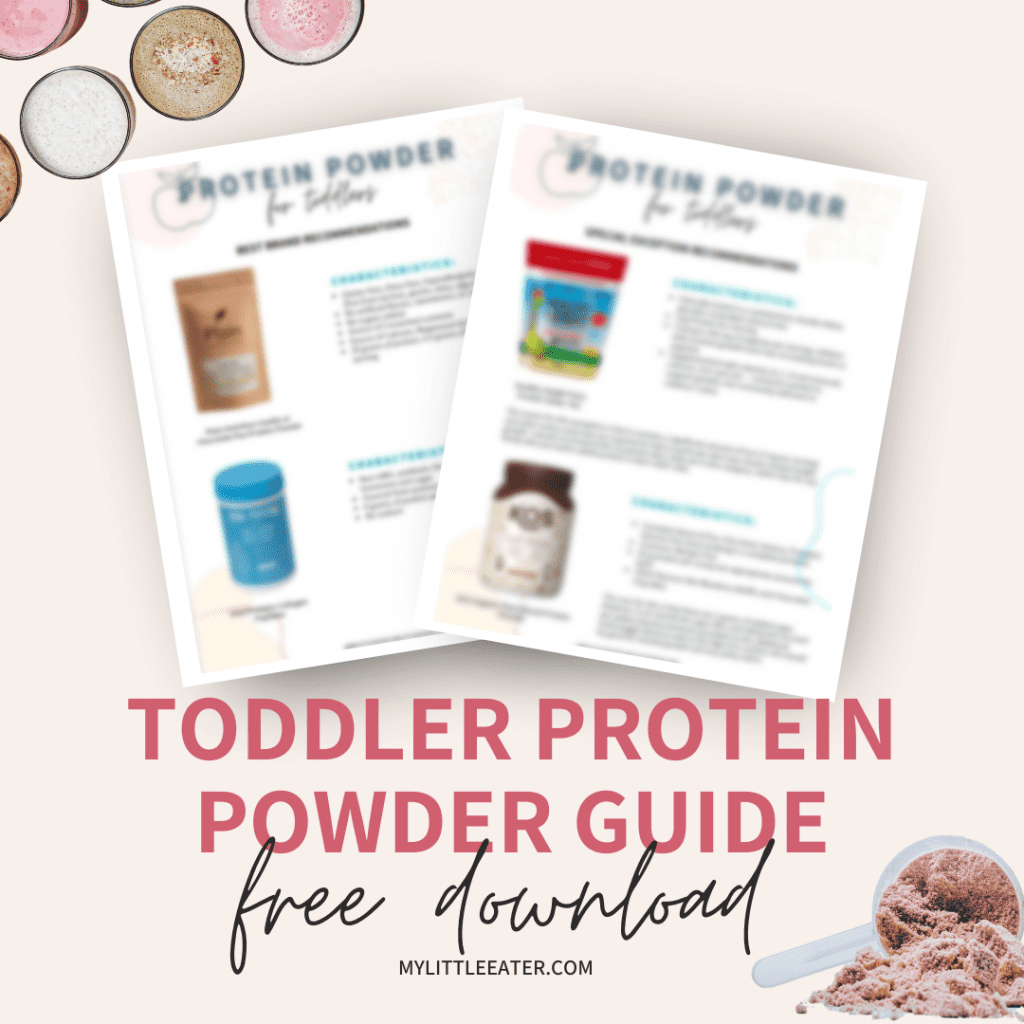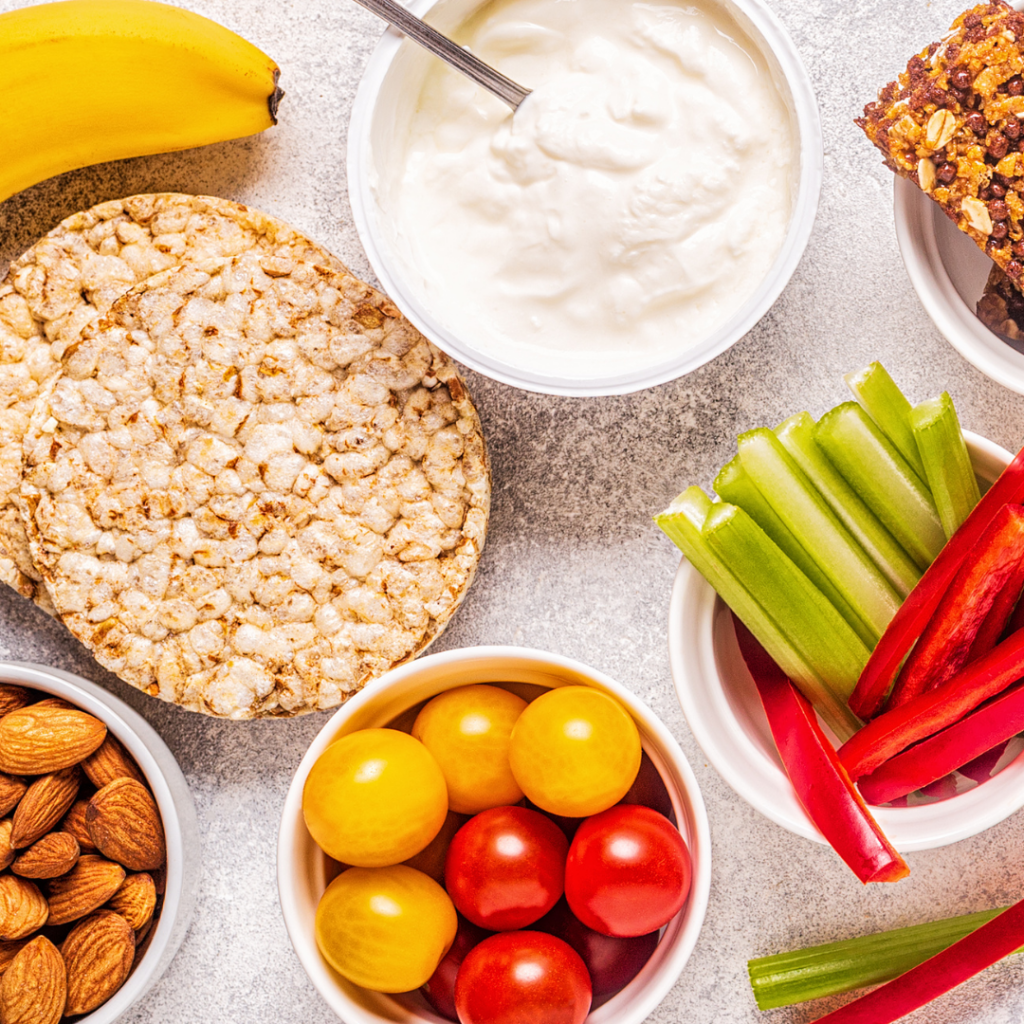Bonus Material: Kid-friendly Protein Powder Guide
We all know that protein is an important nutrient, particularly when being active…and since toddlers are constantly on the go, this is probably one of the most common nutrients of concern for parents. And because of that, I often get questions about whether or not protein powder or protein supplements are safe for toddlers.
That’s why I’m going to address the issue of protein for toddlers, including how much they actually need and what they need it for. And then also provide you with my expert recommendation on whether protein powder can be used to supplement protein for toddlers – spoiler – they can and I’ll teach you what to look for!
Plus, be sure to download my free kid-friendly protein powder guide with my favorite brand recommendations to make your shopping a little bit easier, and pediatric dietitian-approved!

Table of Contents
Protein is an essential macronutrient needed for the growth, repair, and overall maintenance of the body. It’s also super important for balancing blood sugars and providing amino acids to the body (think of these as the building blocks of protein). Out of the 20 amino acids, 9 of them are essential, which means that the body can’t make them on its own, so they must be provided through the diet (via protein).
But sometimes, it’s hard to get protein into your toddler, and concerns that you have an underweight toddler or a picky eater may have you wondering if you should be offering them a protein supplement, like protein powder for kids. Is protein powder safe? Which protein powder is best for toddlers?
Don’t worry – I’ve got you covered in this blog post.
If you want to skip over the rationale and details of which protein powders are best for your toddler or preschooler, and want to jump right into my dietitian-recommended top picks – download this free list here – complete with brand images to make shopping easier!
How much protein do toddlers & preschoolers need?
- 1-3 years old: 13 grams of protein per day
- 4-8 years old: 19 grams of protein per day
Protein is extremely important for managing your toddler’s blood sugars throughout the day. When protein is present at each meal, in high enough quantities, it slows down digestion which also lowers any sugar spike that may come after the meal.
Some children are much more susceptible to fluctuating blood sugars than others. It’s important to make sure each meal contains at least 5 g of protein to keep your toddler full and ensure their blood sugars don’t spike.
The more carbohydrate-heavy a meal is, the more protein and healthy fat you want to include above and beyond this to make sure their blood sugar levels don’t spike. Making sure you’re spreading protein out throughout the day, in equal and sufficient amounts, is the best strategy.
Can protein needs be met through food?

Technically, protein needs can be met even with a high carbohydrate diet!
For example, 3/4 cup of spaghetti has 11 grams of protein, 1/2 cup of quinoa has 4 grams of protein and 1 slice of bread has about 3-4 grams of protein!
That being said, the quality of protein in most grains is low and it doesn’t provide the essential amino acids required for optimal health. Furthermore, although there’s protein found in each of these high carbohydrate foods – they’re so high in carbohydrates that it outweighs the blood sugar balance benefits that a higher protein, lower carbohydrate food would provide.
Protein rich foods include...

- ¼ cup chicken: 10 grams of protein
- ½ cup of edamame: 9 grams of protein (vegan)
- 1 cup milk: 8 grams of protein
- ¼ cup cooked lentils: 8 grams of protein (vegan)
- ½ cup chickpeas: 7 grams of protein (vegan)
- 1 large egg: 7 grams of protein
- ¼ cup cooked quinoa: 6 grams of protein (vegan)
- 1 tbsp peanut butter: 3.5 grams of protein (vegan)
- 1 oz tofu: 3 grams of protein (vegan)
This begs the question... is protein powder necessary for my toddler?

Protein powder technically isn’t necessary for babies or toddlers as they already have low protein needs per day and protein deficiency is extremely uncommon at this age. The only exceptions to this would be if your toddler:
- Has been diagnosed with a medical condition that affects nutrient absorption, height, or other growth issues.
- Has a lack of appetite due to medical conditions.
- Is underweight.
- Food intolerances or picky eating that keeps your toddler from eating protein sources like dairy, seeds, or meat. For example, children who eat vegetarian or vegan diets may need to consider supplementing their protein.

If you’re worried your toddler isn’t meeting their protein intake requirements, I suggest trying to meet their needs through a foods-first approach. However, it’s understandable that when it comes to picky eaters it can be tricky getting them to eat in enough quantity, or eat the right types of foods.
And let’s be real, sometimes families just need a quick and easy option, especially for snacks or meals on the go. This is where protein powders, or protein-supplemented foods, can be of help.
How to add protein powder to your child's diet
- Add it to smoothies/shakes (find two of my favorite smoothie recipes to try here).
- Mix it into your child’s yogurt, oatmeal, or pudding (you can even add it to my favorite oatmeal finger recipe).
- Add it to waffle or pancake batter.
- Add it to cookie or muffin batter.
- Make protein balls.

Plus, check out this healthy, kid-approved alternative to Reese’s peanut butter cups using a protein powder!
How much protein powder is too much for my toddler?
Too many protein supplements can crowd out room for other foods and nutrients. Most brands of protein powder contain 20-30 g of protein per serving.
Assess the brand’s serving size and what your child’s needs are that day, and give them an amount that will do what you intended: supplement their protein needs. You may want to consider portioning a half serving, or less, depending on the age and protein needs of your child.

There is no good evidence showing that too much protein can cause reduced kidney function or any harm to the body in otherwise healthy children. In addition, there’s also no evidence that higher-protein diets cause obesity or any other negative health outcomes unless calorie intake is also very high.
While there is no exact number out there that says “your toddler should not have more than X amount of protein”, most research found says that a safe and more conservative limit is 2g of protein per kg of body weight per day.
Don’t get too hung up on the exact number of grams of protein though!
As long as you’re not exclusively offering your child protein-supplemented products (eg. protein bars, protein shakes, protein powders, etc.), and you are trying to rely on more whole foods than processed protein supplements, there should be no worry.

I also want to reiterate that you should not be adding extra protein to each meal in place of other macronutrients like fats, carbohydrates, and fiber. It is important to have an ‘all around’ meal when it comes to macronutrients as they all have benefits and different nutrients that your child will need.
Which protein powders are best?
Protein powders are all made with different base sources of protein, and many have added ingredients.
In my protein powder guide, I give you the best and safest protein powders for your toddler, preschooler, and beyond based on the cleanest ingredients and most nutrients for your little one.
Let’s first go through which protein source is best for your little one. And don’t forget to grab my free guide to see my top recommended brands!
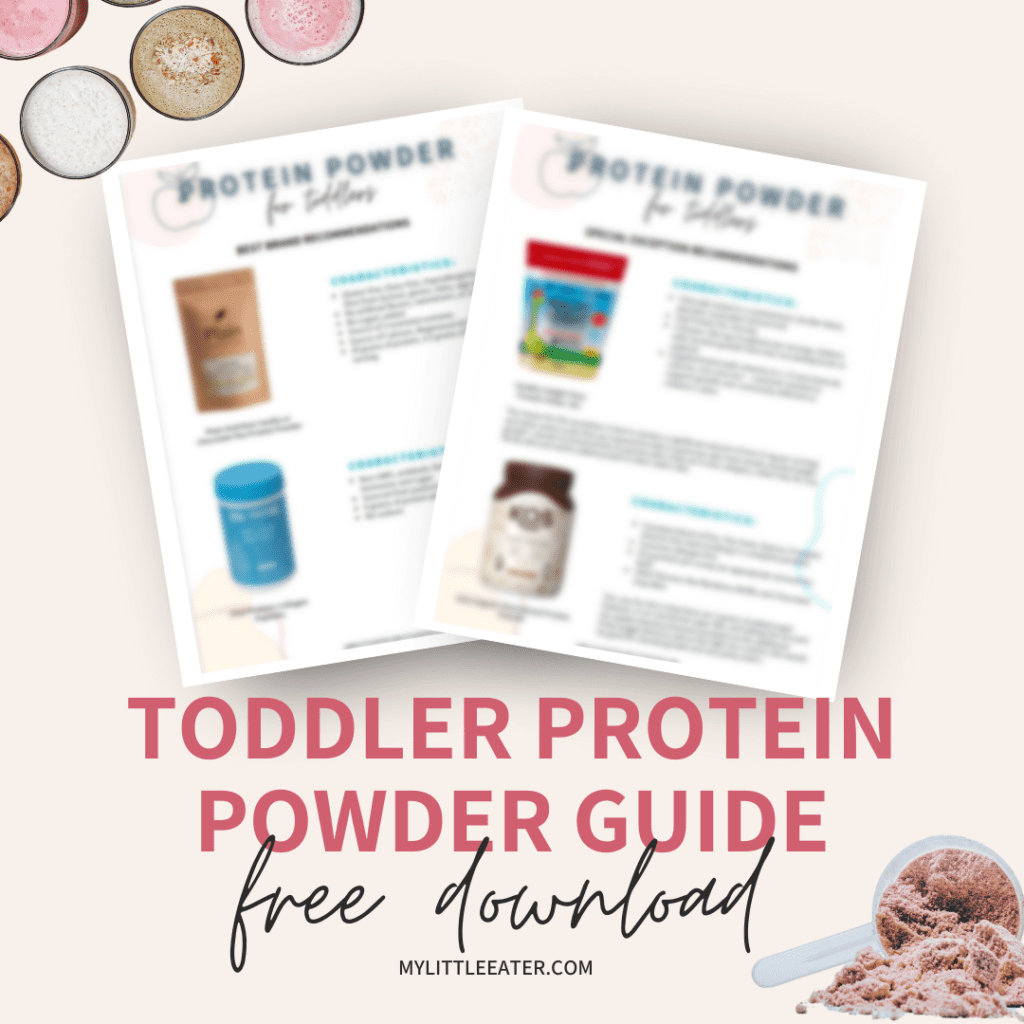
Best Choice - Whey Protein
Whey protein is one of the two proteins found in milk and it is comprised of all nine amino acids, which promotes the best muscle recovery and muscle-building effects.
If your baby has ever had formula, they have also had whey protein! It also makes up 70% of the protein in breast milk. So naturally, it’s extremely easy to digest and the ability for the body to absorb the nutrients from whey protein surpasses all other forms of protein.
It’s particularly rich in calcium, healthy fats, and other beneficial compounds, such as omega-3 fatty acids (when from a grass-fed cow). Because whey is found in milk, this also means it should be treated as an allergen and isn’t suitable for those with a dairy allergy.
There are two types of whey protein – concentrate and isolate. Whey protein isolate is the one to look for, as it has a higher % of protein and contains a very low amount of lactose, which may make it more tolerated by those with lactose sensitivity.
Runners Up

Hemp protein
Hemp protein is a great option for toddlers who suffer from a dairy allergy. Although some hemp protein products are gluten-free, most aren’t certified, so be careful of that.
While it is a complete protein containing every essential amino acid, more research is needed on the quality/quantity of all these amino acids. I do like that it’s one of the least processed protein sources, and I love that it also contains healthy fats and fibre in addition to protein.
Pea protein

Pea protein is a natural, plant-based protein, is gluten-free and allows for easier and slightly quicker digestion and absorption, with less bloating. Pea protein is higher in leucine than other vegan protein powders, which is important for muscle building and growth in the early years.
However, it’s not a complete protein as it lacks 2 amino acid types so you’d need to combine it with other types of protein throughout the day to make up for that.
Note: Pea protein is extracted using hexane*. More on that to come!
Collagen

Collagen is a great protein source and is great for skin, hair, and nails. However, it is lower in essential amino acids that we cannot make — especially tryptophan and leucine, compared to a traditional protein source like whey, or multi-source vegan protein.
What I do like about it though is that it’s easy to find pure collagen powder (no funny ingredients added) and it’s not as potent a protein source (about 10 g protein per serving), which is enough as a great boost for toddlers, without filling them up too much. Look for either hydrolyzed collagen or collagen peptides.
Other great options

You’ll also find protein powders made from other plant-based ingredients that – although aren’t complete proteins in and of themselves – can be combined together in a blend with the right combinations to make a complete protein – or – just consumed on their own as non-complete proteins, which is still helpful in certain situations.
These include:
- Peanut powder
- Sunflower seed powder
- Pumpkin seed powder
- Bean/lentil protein

What to avoid in protein powders for toddlers?
Sweeteners
Look for a protein powder that is ideally unsweetened. This means no added sugar or any artificial sweeteners. You can add fruit as a natural sweetener in smoothies quite easily, or bake it into muffins, etc.

If you want one that’s sweetened, opt for one that gets a bit of added sweetness from whole fruit. With that being said, some monk fruit sweetener or stevia is ok for them – just be sure to really watch for symptoms of digestive issues.
I include some sweetened brands in the free protein powder brand guide that meet my standards if you’re in the market for a vanilla or chocolate-flavored powder!
Artificial flavors, additives, and fillers
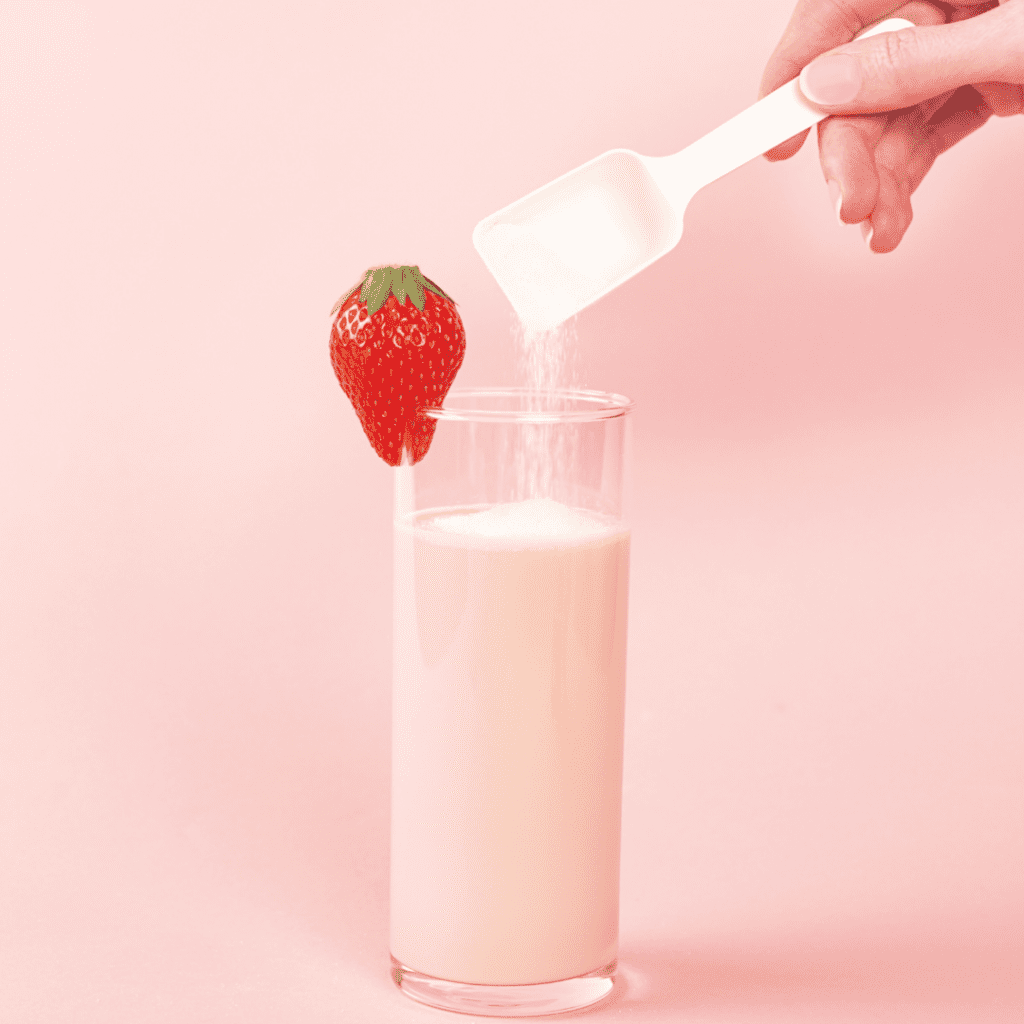
Avoid any products with artificial flavors, as well as ingredients that end in “dextrin” (like maltodextrin, a cheap, highly processed food additive usually made from GMO corn).
Soy and sunflower lecithin are common additives that are extracted from raw soybeans or sunflowers using a chemical solvent (again…hexane*).
Vegetable oils are inflammatory and ideally should be avoided as well.
Please note that none of these things are things to stress about, or that cause harm to your child in normal amounts. These are just things to avoid when possible.
Soy and rice-based products
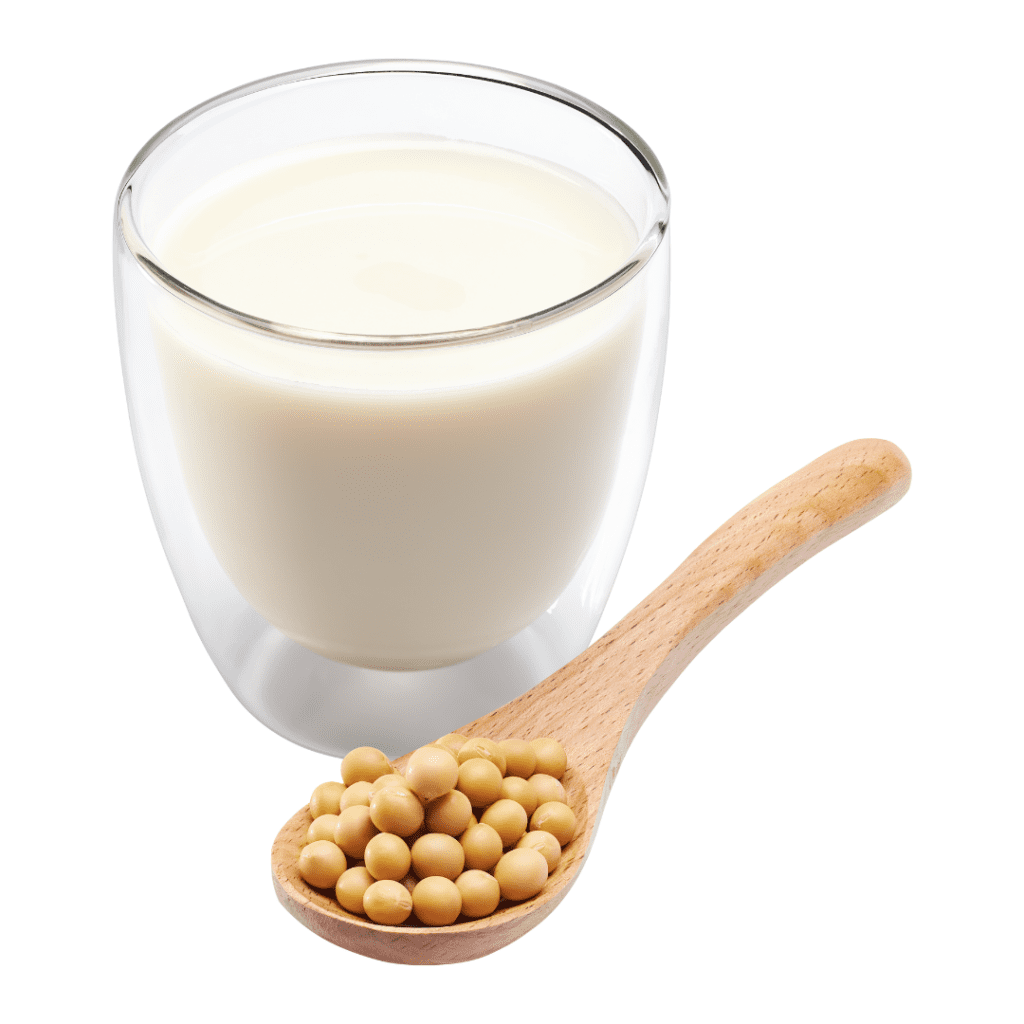
Although rice-based products sound extremely enticing and healthy, they are better to minimize as they commonly contain high levels of arsenic.
Soy protein powder is made from unfermented soybeans – soybeans that, unlike tempeh and soy sauce, haven’t undergone fermentation. This means that they have an extremely high phytic acid and phytoestrogen content. Most soy has also been genetically modified.
Protein isolates extracted using hexane
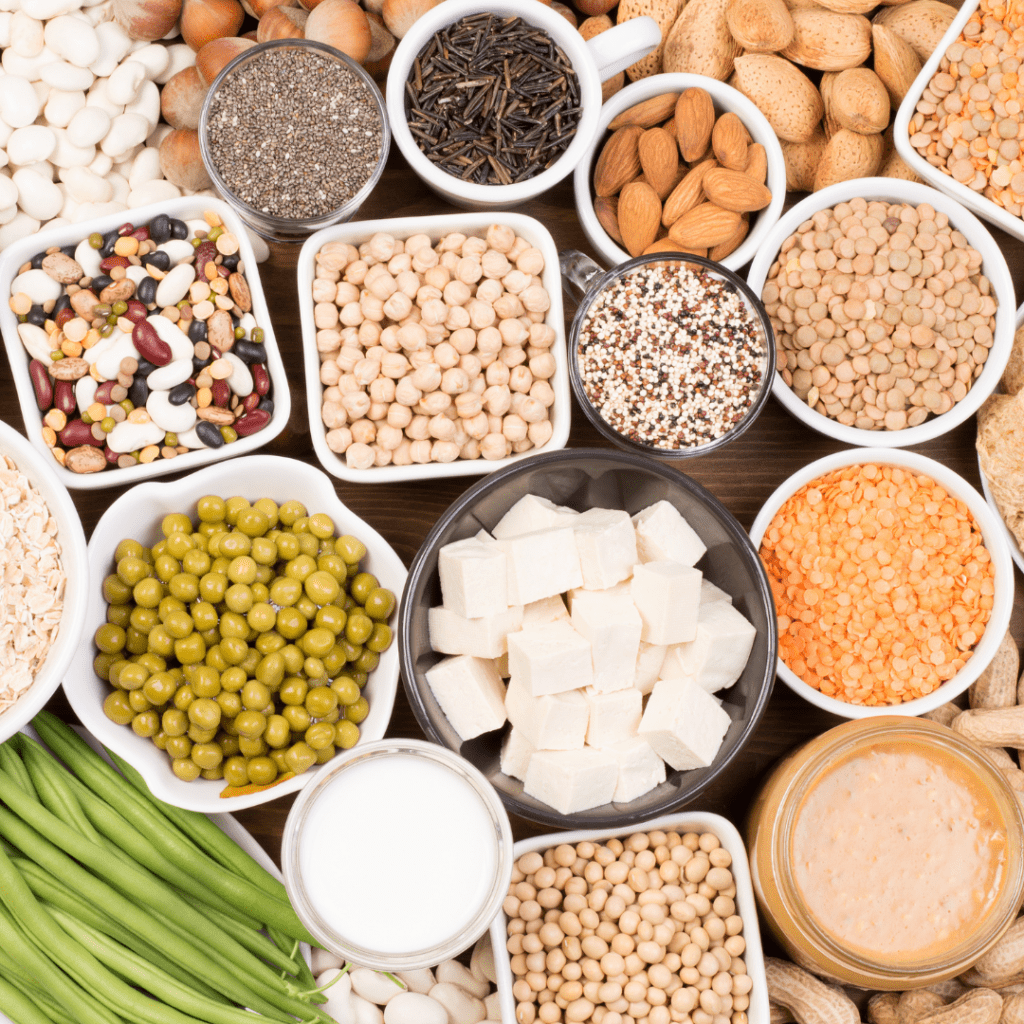
Vegan and vegetarian proteins (particularly soy) are often extracted using hexane. Hexane is a chemical neurotoxin, and during extraction, not all the hexane can be removed. Therefore, some will remain within the protein powder. Because there are no limits that are known to be safe yet, many people avoid vegetarian protein products extracted with hexane, especially for kids.
Get the protein powder guide for toddlers!
To get the curated list of best protein powders for toddlers (as ranked by all the criteria listed above) to print out for your quick reference – download the free guide below (complete with protein powder brand images to make shopping easier)!
Did you find this helpful? Pin it to save for later!
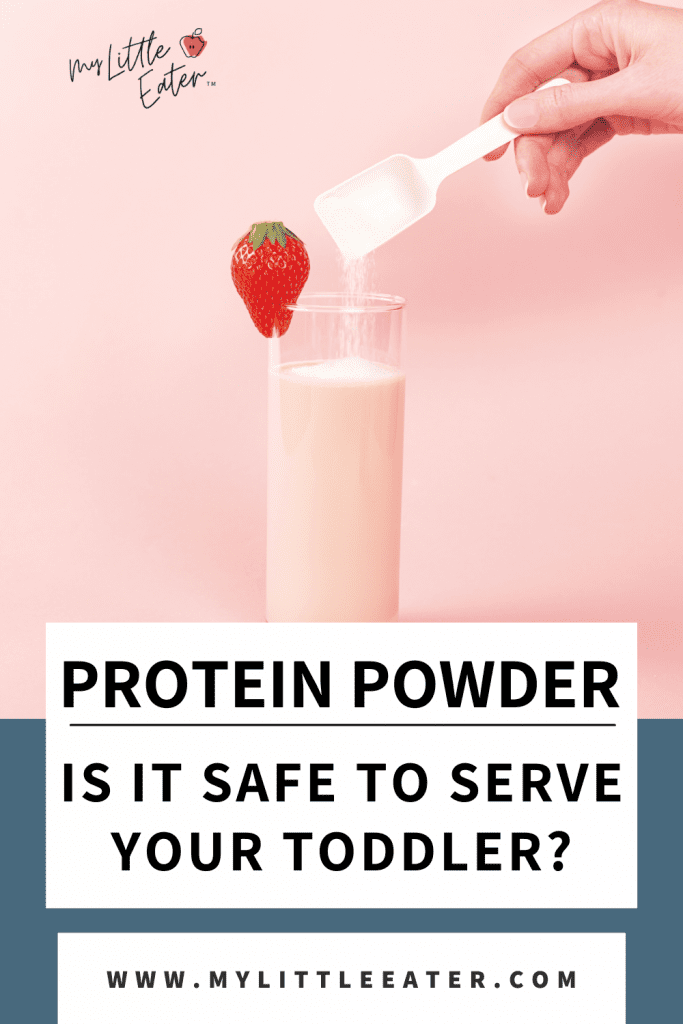

about the author
EDWENA KENNEDY, RD
Founder and lead Registered Pediatric Dietitian at My Little Eater Inc., creator of The Texture Timeline™, and mom of two picky-turned-adventurous eaters.

about the author
EDWENA KENNEDY, RD
Founder and lead Registered Pediatric Dietitian at My Little Eater Inc., creator of The Texture Timeline™, and mom of two picky-turned-adventurous eaters.

